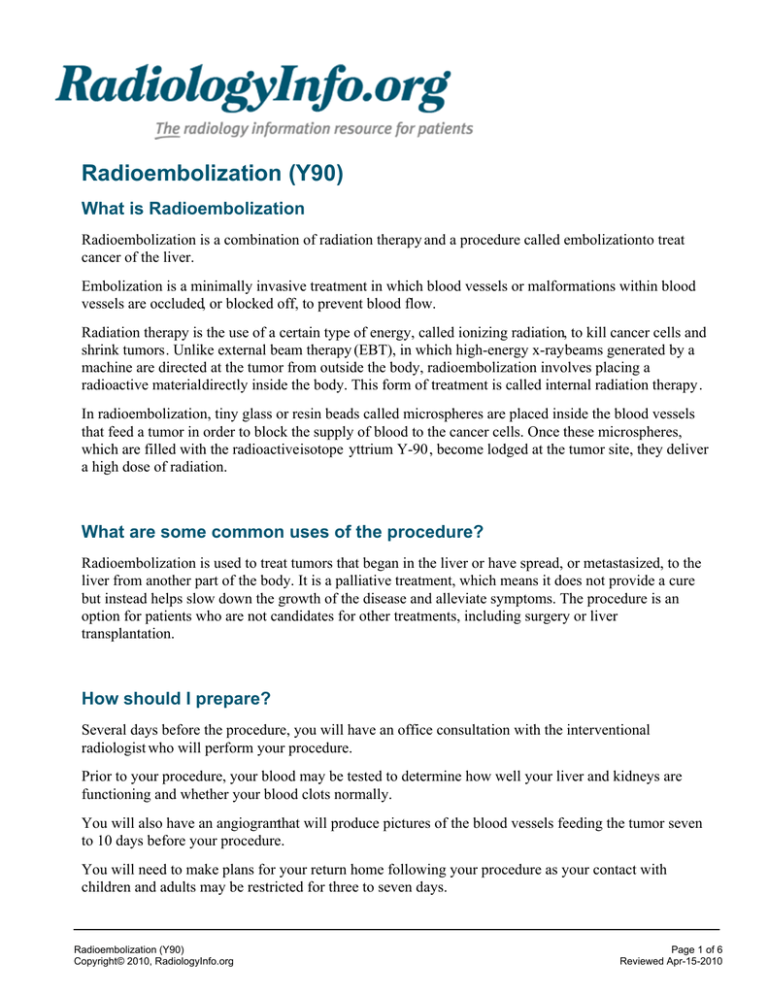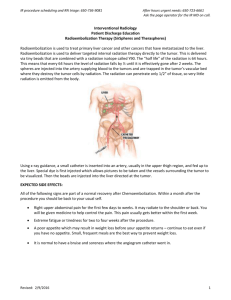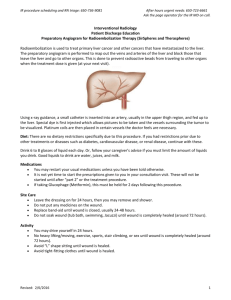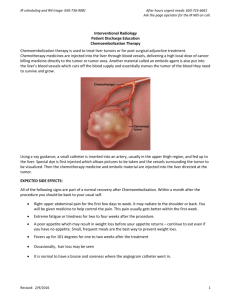Radioembolization (Y90) What is Radioembolization
advertisement

Radioembolization (Y90) What is Radioembolization Radioembolization is a combination of radiation therapy and a procedure called embolizationto treat cancer of the liver. Embolization is a minimally invasive treatment in which blood vessels or malformations within blood vessels are occluded, or blocked off, to prevent blood flow. Radiation therapy is the use of a certain type of energy, called ionizing radiation, to kill cancer cells and shrink tumors. Unlike external beam therapy (EBT), in which high-energy x-ray beams generated by a machine are directed at the tumor from outside the body, radioembolization involves placing a radioactive material directly inside the body. This form of treatment is called internal radiation therapy. In radioembolization, tiny glass or resin beads called microspheres are placed inside the blood vessels that feed a tumor in order to block the supply of blood to the cancer cells. Once these microspheres, which are filled with the radioactive isotope yttrium Y-90, become lodged at the tumor site, they deliver a high dose of radiation. What are some common uses of the procedure? Radioembolization is used to treat tumors that began in the liver or have spread, or metastasized, to the liver from another part of the body. It is a palliative treatment, which means it does not provide a cure but instead helps slow down the growth of the disease and alleviate symptoms. The procedure is an option for patients who are not candidates for other treatments, including surgery or liver transplantation. How should I prepare? Several days before the procedure, you will have an office consultation with the interventional radiologist who will perform your procedure. Prior to your procedure, your blood may be tested to determine how well your liver and kidneys are functioning and whether your blood clots normally. You will also have an angiogramthat will produce pictures of the blood vessels feeding the tumor seven to 10 days before your procedure. You will need to make plans for your return home following your procedure as your contact with children and adults may be restricted for three to seven days. Radioembolization (Y90) Copyright© 2010, RadiologyInfo.org Page 1 of 6 Reviewed Apr-15-2010 You should report to your doctor all medications that you are taking, including herbal supplements, and if you have any allergies, especially to local anesthetic medications, general anesthesiaor to contrast materials (also known as "dye" or "x-ray dye"). Your physician may advise you to stop taking aspirin, nonsteroidal anti-inflammatory drugs (NSAIDs) or a blood thinner for a specified period of time before your procedure. Also inform your doctor about recent illnesses or other medical conditions. Women should always inform their physician and x-ray technologist if there is any possibility that they are pregnant. Many imaging tests are not performed during pregnancy so as not to expose the fetus to radiation. If an x-ray is necessary, precautions will be taken to minimize radiation exposure to the baby. See the Safety page (www.RadiologyInfo.org/en/safety/) for more information about pregnancy and x-rays. You will receive specific instructions on how to prepare, including any changes that need to be made to your regular medication schedule. You will be given a sedative during the procedure. You will receive specific instructions on eating and drinking before the procedure and will need to have a relative or friend accompany you and drive you home afterward. You will be given a gown to wear during the procedure. What does the equipment look like? In this procedure, x-ray equipment, a catheter and microspheres, or tiny glass beads filled with the radioisotope yttrium-90 are used. Radioembolization procedures are typically performed using x-ray guidance. The equipment typically used for this examination consists of a radiographic table, an x-ray tube and a television-like monitor that is located in the examining room or in a nearby room. When used for viewing images in real time (called fluoroscopy), the image intensifier (which converts x-rays into a video image) is suspended over a table on which the patient lies. When used for taking still pictures, the image is captured either electronically or on film. A catheter is a long, thin plastic tube, about as thick as a strand of spaghetti. Millions of glass beads, amounting to about half a teaspoon full, each of which is smaller in diameter than a human hair, deliver the ionizing radiation. Other equipment that may be used during the procedure includes an intravenous line (IV) and equipment that monitors your heart beat and blood pressure. How does the procedure work? Using x-ray imaging and a contrast materialto visualize the blood vessels, the interventional radiologist inserts a catheter through the skin into a blood vessel and advances it to the treatment site. The radiation-filled microspheres, or glass beads, are then inserted through the catheter and advanced to the Radioembolization (Y90) Copyright© 2010, RadiologyInfo.org Page 2 of 6 Reviewed Apr-15-2010 radiation-filled microspheres, or glass beads, are then inserted through the catheter and advanced to the blood vessels supplying the tumor with blood. Once the microspheres lodge at the tumor site, they deliver a high dosage of radiation directly to the cancer cells. The microspheres will block the flow of blood to the tumor, depriving the diseased cells of the oxygen and nutrients needed to grow. There are two primary blood vessels that bring blood to the liver. Normal liver tissue receives about 75 percent of its blood supply from the portal vein and about 25 percent from the hepatic artery and its branches. When a tumor grows in the liver, it receives almost all of its blood supply from the hepatic artery. Because radioactive microspheres are delivered through the hepatic artery, they reach the tumor very directly while sparing most of the healthy liver tissue. The radiation from yttrium-90 continually decreases over a two-week period and disappears after 30 days. The tiny microspheres remain in the liver without causing any problems. How is the procedure performed? Image-guided, minimally invasive procedures such as radioembolization are most often performed by a specially trained interventional radiologist in an interventional radiologysuite or occasionally in the operating room. An initial arteriogram as described below is performed to visualize the upper abdominal arteries. At that time, arteries to areas of the stomach and duodenum which may have beads flow into them are closed with tiny coils of wire. At the end of the procedure, a bead with a nuclear medicine tracer on it is injected through the catheter to simulate the treatment. This will allow the interventional radiologist to calculate how much of the treatment dose can go to the lungs so that lung damage does not occur. This procedure is often done on an outpatient basis. However, some procedures may require admission. Please consult with your physician. You may be given medications to help prevent nausea and pain, and antibiotics to help prevent infection. You will be positioned on your back. You will be connected to monitors that track your heart rate, blood pressure and pulse during the procedure. A nurse or technologist will insert an intravenous (IV) line into a vein in your hand or arm so that sedative medication can be given intravenously. You may also receive general anesthesia. The area of your body where the catheter is to be inserted will be shaved, sterilized and covered with a surgical drape. Your physician will numb the area with a local anesthetic. A very small nick is made in the skin at the site. Using image-guidance, a catheter(a long, thin, hollow plastic tube) is inserted through the skin into the femoral artery, a large groin blood vessel, and maneuvered to the treatment site. Once the catheter is positioned in the branches of the hepatic artery that are feeding the tumor, the tiny Radioembolization (Y90) Copyright© 2010, RadiologyInfo.org Page 3 of 6 Reviewed Apr-15-2010 glass beads or microspheres are injected through the catheter to the site. Over the next 10 to 14 days, the radiation will be released from the microspheres lodged in the blood vessels. At the end of the procedure, the catheter will be removed and pressure will be applied to stop any bleeding. The opening in the skin is then covered with a dressing. No sutures are needed. Your intravenous line will be removed. This procedure is usually completed within an hour. What will I experience during and after the procedure? Devices to monitor your heart rate and blood pressure will be attached to your body. You will feel a slight pin prick when the needle is inserted into your vein for the intravenous line (IV) and when the local anesthetic is injected. If the case is done with sedation, the intravenous (IV) sedative will make you feel relaxed and sleepy. You may or may not remain awake, depending on how deeply you are sedated. You may feel slight pressure when the catheter is inserted but no serious discomfort. As the contrast material passes through your body, you may get a warm feeling. Radioembolization is generally painless; however, some patients may experience brief pain when the microspheres are injected. Pain that continues for more than six to eight hours usually means an ulcer has developed in the patient’s stomach or duodenum. These ulcers would be treated as any other ulcer. You will remain in the recovery room until you are completely awake and ready to return home. Few patients experience some side effects called post-embolization syndrome, including nausea, vomiting and fever. Pain is the most common side effect that occurs because the blood supply to the treated area is cut off. It can readily be controlled by medications given by mouth or your IV. These side effects usually subside within three to five days and may be alleviated with medication. You should tell your doctor if these symptoms last more than seven to 10 days. You may also experience a low grade fever, lethargy and fatigue that usually lasts about one week. You should be able to resume normal activities within a day or two following the procedure. During the week following your radioembolization, you will need to limit contact with others while the radiation in your body diminishes. You should not do the following for at least seven days after the procedure: sleep in the same bed as your partner. use public transportation that requires you to sit next to another person for more than two hours. come in close contact with children or pregnant women. Radioembolization may be performed in two separate treatments if there are tumors on both sides of the liver. CT scans or MRI may be performed every three months following the treatment to determine the size of the treated tumor. Radioembolization (Y90) Copyright© 2010, RadiologyInfo.org Page 4 of 6 Reviewed Apr-15-2010 Who interprets the results and how do I get them? The interventional radiologist can advise you as to whether the procedure was a technical success when it is completed. What are the benefits vs. risks? Benefits For patients with inoperable tumors, radioembolization can extend lives from months to years and improve quality of life. In some cases, it may allow for more curative options such as surgery or liver transplantation. Radioembolization produces fewer side effects compared to standard radiation therapy. No surgical incision is needed—only a small nick in the skin that does not have to be stitched closed. A higher dose of radiation to be given during radioembolization than with standard external beam therapy. Risks Any procedure where the skin is penetrated carries a risk of infection. The chance of infection requiring antibiotic treatment appears to be less than one in 1,000. There is a very slight risk of an allergic reaction if contrast materialis injected. Any procedure that involves placement of a catheter inside a blood vessel carries certain risks. These risks include damage to the blood vessel, bruising or bleeding at the puncture site, and infection. There is a risk that the microspheres may lodge in the wrong place, putting the patient at risk for an ulcer in the stomach or duodenum. This happens in approximately two percent of patients. There is a risk of infection after radioembolization, even if an antibiotic has been given. Because angiography is part of the procedure, there is a risk of an allergic reaction to the contrast material. What are the limitations of Radioembolization? Radioembolization is not recommended in cases where severe liver or kidney dysfunction, abnormal blood clotting or a blockage of the bile ducts. In some cases—despite liver dysfunction—radioembolization may be done in small amounts and in several procedures to try and minimize the effect on the normal liver. Radioembolization is a treatment, not a cure. Approximately 70 percent of the patients will see improvement in the liver and, depending on the type of liver cancer, it may improve survival rates. Radioembolization (Y90) Copyright© 2010, RadiologyInfo.org Page 5 of 6 Reviewed Apr-15-2010 Disclaimer This information is copied from the RadiologyInfo Web site (http://www.radiologyinfo.org) which is dedicated to providing the highest quality information. To ensure that, each section is reviewed by a physician with expertise in the area presented. All information contained in the Web site is further reviewed by an ACR (American College of Radiology) - RSNA (Radiological Society of North America) committee, comprising physicians with expertise in several radiologic areas. However, it is not possible to assure that this Web site contains complete, up-to-date information on any particular subject. Therefore, ACR and RSNA make no representations or warranties about the suitability of this information for use for any particular purpose. All information is provided "as is" without express or implied warranty. Please visit the RadiologyInfo Web site at http://www.radiologyinfo.org to view or download the latest information. Note: Images may be shown for illustrative purposes. Do not attempt to draw conclusions or make diagnoses by comparing these images to other medical images, particularly your own. Only qualified physicians should interpret images; the radiologist is the physician expert trained in medical imaging. Copyright This material is copyrighted by either the Radiological Society of North America (RSNA), 820 Jorie Boulevard, Oak Brook, IL 60523-2251 or the American College of Radiology (ACR), 1891 Preston White Drive, Reston, VA 20191-4397. Commercial reproduction or multiple distribution by any traditional or electronically based reproduction/publication method is prohibited. Copyright ® 2010 Radiological Society of North America, Inc. Radioembolization (Y90) Copyright© 2010, RadiologyInfo.org Page 6 of 6 Reviewed Apr-15-2010






